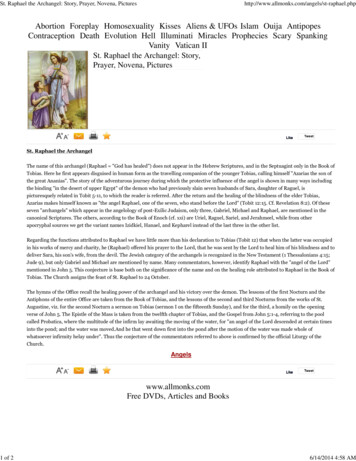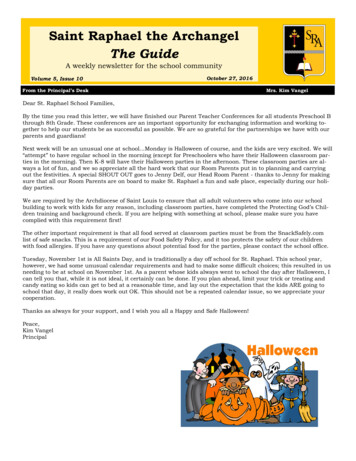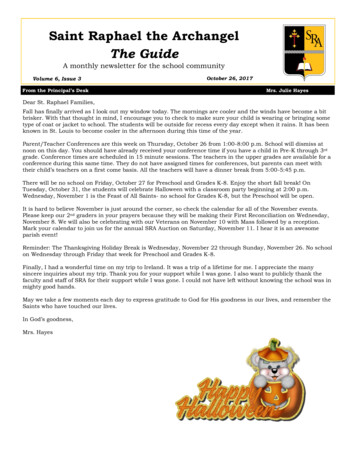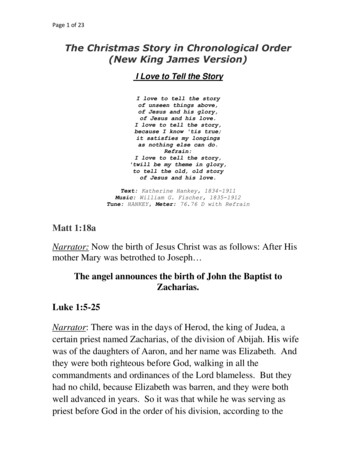
Transcription
St. Raphael the Archangel: Story, Prayer, Novena, Pictures1 of tion Foreplay Homosexuality Kisses Aliens & UFOs Islam Ouija AntipopesContraception Death Evolution Hell Illuminati Miracles Prophecies Scary SpankingVanity Vatican IISt. Raphael the Archangel: Story,Prayer, Novena, PicturesLikeTweetSt. Raphael the ArchangelThe name of this archangel (Raphael "God has healed") does not appear in the Hebrew Scriptures, and in the Septuagint only in the Book ofTobias. Here he first appears disguised in human form as the travelling companion of the younger Tobias, calling himself "Azarias the son ofthe great Ananias". The story of the adventurous journey during which the protective influence of the angel is shown in many ways includingthe binding "in the desert of upper Egypt" of the demon who had previously slain seven husbands of Sara, daughter of Raguel, ispicturesquely related in Tobit 5-11, to which the reader is referred. After the return and the healing of the blindness of the elder Tobias,Azarias makes himself known as "the angel Raphael, one of the seven, who stand before the Lord" (Tobit 12:15. Cf. Revelation 8:2). Of theseseven "archangels" which appear in the angelology of post-Exilic Judaism, only three, Gabriel, Michael and Raphael, are mentioned in thecanonical Scriptures. The others, according to the Book of Enoch (cf. xxi) are Uriel, Raguel, Sariel, and Jerahmeel, while from otherapocryphal sources we get the variant names Izidkiel, Hanael, and Kepharel instead of the last three in the other list.Regarding the functions attributed to Raphael we have little more than his declaration to Tobias (Tobit 12) that when the latter was occupiedin his works of mercy and charity, he (Raphael) offered his prayer to the Lord, that he was sent by the Lord to heal him of his blindness and todeliver Sara, his son's wife, from the devil. The Jewish category of the archangels is recognized in the New Testament (1 Thessalonians 4:15;Jude 9), but only Gabriel and Michael are mentioned by name. Many commentators, however, identify Raphael with the "angel of the Lord"mentioned in John 5. This conjecture is base both on the significance of the name and on the healing role attributed to Raphael in the Book ofTobias. The Church assigns the feast of St. Raphael to 24 October.The hymns of the Office recall the healing power of the archangel and his victory over the demon. The lessons of the first Nocturn and theAntiphons of the entire Office are taken from the Book of Tobias, and the lessons of the second and third Nocturns from the works of St.Augustine, viz. for the second Nocturn a sermon on Tobias (sermon I on the fifteenth Sunday), and for the third, a homily on the openingverse of John 5. The Epistle of the Mass is taken from the twelfth chapter of Tobias, and the Gospel from John 5:1-4, referring to the poolcalled Probatica, where the multitude of the infirm lay awaiting the moving of the water, for "an angel of the Lord descended at certain timesinto the pond; and the water was moved.And he that went down first into the pond after the motion of the water was made whole ofwhatsoever infirmity helay under". Thus the conjecture of the commentators referred to above is confirmed by the official Liturgy of theChurch.AngelsLikeTweetwww.allmonks.comFree DVDs, Articles and Books6/14/2014 4:58 AM
St. Raphael the Archangel: Story, Prayer, Novena, Pictures2 of 2MOST POPULAR pMOST POPULAR ARTICLESDoomsday PredictionsHappening Right NowProven by Scientists!Are You Ready?Scientific Proof forGod and SupernaturalMiraclesBenedict XVI deniesthe Catholic Faith byteaching that FalseReligions Saves!Martin Luther said thatChrist Fornicated withthree women!Real Ghosts AttackPeople On Camera!Real Exorcisms OfDemons Attacking OnCameraJohn Paul II taught thatFalse Religions isFrom God!Sexual Pleasure andLust within MarriageThe Revelations of St.Bridget (MUSTREAD)Spiritual InformationYou Must Know to beSavedChristian Dogma YouMust Believe to beSavedWe are Looking forHelpers andTranslatorsVatican II Heresies andAntipopes ExposedThe Bible Proves theTeachings of theCatholic ChurchPadre Pio's Life andMiraclesReceiving SacramentsFrom Heretics is aMortal Sin!FREE DVDS & VIDEOSScientificReal GhostsProof for God Attack Peopleandon eningRight Now!Are YouReady?RealExorcisms ofDemonsAttacking onCameraAntichristConspiracies& End TimesPropheciesWAT C H & D O W N L O A D A L L O U R D V D S & V I D E O S F O R F R E E !6/14/2014 4:58 AM
JerahmeelWikibookPDF generated using the open source mwlib toolkit. See http://code.pediapress.com/ for more information.PDF generated at: Sat, 14 Jun 2014 09:38:53 UTC
ContentsArticlesJerahmeel1Jerahmeel (archangel)2ReferencesArticle Sources and Contributors3Image Sources, Licenses and Contributors4Article LicensesLicense5
JerahmeelJerahmeelThe name Jerahmeel (Hebrew יְרַחְמְאֵל , Greek ιραμεηλ) appears several times in the Tanakh. It means "He willobtain mercy of God"[1] or "God pities" or "May God have compassion".Bearers of the nameThere are probably three distinct persons of that name in the Tanakh. In order of their lifetimes they are:1. a son of Hezron and great-grandson of Judah, as given in the extended genealogies in 1 Chronicles 2:9 [2],2:25-26 [3] and 2:42 [4].2. a son of Kish, one of the Levites appointed by David to administer the temple worship, as described in1 Chronicles 24:29 [5].3. a son of the king,[6] sent with others by Jehoiakim to arrest Baruch the scribe and Jeremiah the prophet, as givenin Jeremiah 36:26 [7].The JerahmeelitesThe Jerahmeelites were a people, presumably descended from Jerahmeel number 1 above, living in the Negev, whoDavid, while in service with the Philistines, claimed to have attacked (1 Samuel 27:10 [8]), but with whom he wasreally on friendly terms (1 Samuel 30:29 [9]).Cheyne developed a theory which made the Jerahmeelites into a significant part of the history of Israel, but mostsubsequent scholars have dismissed his ideas as fanciful.An ArchangelIn some deuterocanonical and apocryphal writings there are references to an archangel variously called Jeremiel,Eremiel, Remiel, Ramiel etc. See the article Jerahmeel (archangel).The Chronicles of JerahmeelThe Chronicles of Jerahmeel is a mediaeval document ascribed to the 12th century Jewish historian Jerahmeel benSolomon, and is unrelated to any of the above.References[1][2][3][4][5][6][7][8][9]Alfred Jones, Dictionary of Old Testament Proper Names 1856, republished Kregel Publications 1990http:/ / tools. wmflabs. org/ bibleversefinder/ ?book 1%20Chronicles& verse 2:9& src HEhttp:/ / tools. wmflabs. org/ bibleversefinder/ ?book 1%20Chronicles& verse 2:25-26& src HEhttp:/ / tools. wmflabs. org/ bibleversefinder/ ?book 1%20Chronicles& verse 2:42& src HEhttp:/ / tools. wmflabs. org/ bibleversefinder/ ?book 1%20Chronicles& verse 24:29& src HEor, according to the interpretation of the King James version, a son of Hammelechhttp:/ / tools. wmflabs. org/ bibleversefinder/ ?book Jeremiah& verse 36:26& src HEhttp:/ / tools. wmflabs. org/ bibleversefinder/ ?book 1%20Samuel& verse 27:10& src HEhttp:/ / tools. wmflabs. org/ bibleversefinder/ ?book 1%20Samuel& verse 30:29& src HEThis article incorporates text from a publication now in the public domain: Chisholm, Hugh, ed. (1911).Encyclopædia Britannica (11th ed.). Cambridge University Press.1
Jerahmeel (archangel)Jerahmeel (archangel)The Hebrew name Jerahmeel, which appears several times in the Tanakh (see the article Jerahmeel), also appears invarious forms as the name of an archangel in books of the intertestamental and early Christian periods.In the deuterocanonical book 2 Esdras, also known as 4 Ezra, which has come down to us in Latin and appears as anappendix to the Vulgate, there is a reference in chapter 4 verse 36, to Jeremiel (in the Latin Hieremihel), which,however, does not occur in all the manuscripts. Other versions have Remihel, Oriel or Uriel.[1] In this passage theangel or angels (Uriel is also there) are answering Ezra's many questions about heaven and hell.In the Apocalypse of Zephaniah, an apocryphal book which has come down to us in Coptic, the angel referred to asEremiel tells ZephaniahI am the great angel, Eremiel, who is over the abyss and Hades, the one in which all of the souls areimprisoned from the end of the Flood, which came upon the earth, until this day[2]In two or three places in the Book of Enoch, available in Ethiopic, there are lists of angels. Included are Rame'el andRam'el (in the same list). There are occasional references, in various spellings, in other apocryphal manuscripts.For modern uses of the angel's name and identity, see the article Ramiel.ReferencesJames H Charlesworth (ed) The Old Testament Pseudepigrapha, Darton, Longman & Todd, London 1983.[1] Robert Weber (ed.) Biblia Sacra juxta Vulgatam Versionem, Deutsche Bibelgesellschaft, Stuttgart, 1969[2] The Apocalypse of Zephaniah, section 7, in Charlesworth, volume 12
Article Sources and ContributorsArticle Sources and ContributorsJerahmeel Source: https://en.wikipedia.org/w/index.php?oldid 608331441 Contributors: Bazuz, Charles Matthews, Conscious, Eastlaw, FDuffy, Gaius Cornelius, Gilgamesh, Jheald, LeszekJańczuk, R.vrillon, Rjwilmsi, RobyWayne, Roscelese, SamuelTheGhost, Sirmylesnagopaleentheda, Squids and Chips, Stan Shebs, Tad Lincoln, Til Eulenspiegel, Uriber, 4 anonymous editsJerahmeel (archangel) Source: https://en.wikipedia.org/w/index.php?oldid 609776443 Contributors: Eliyyahu, Estel, Hijigne, Iscariot, RJFJR, SamuelTheGhost, Simetrical, 6 anonymous edits3
Image Sources, Licenses and ContributorsImage Sources, Licenses and ContributorsFile:PD-icon.svg Source: https://en.wikipedia.org/w/index.php?title File:PD-icon.svg License: Public Domain Contributors: Alex.muller, Anomie, Anonymous Dissident, CBM, MBisanz,PBS, Quadell, Rocket000, Strangerer, Timotheus Canens, 1 anonymous edits4
LicenseLicenseCreative Commons Attribution-Share Alike 3.0//creativecommons.org/licenses/by-sa/3.0/5
http://www.20000-names.com/angel names messenger names.htm
deliver Sara, his son's wife, from the devil. The Jewish category of the archangels is recognized in the New Testament (1 Thessalonians 4:15; Jude 9), but only Gabriel and Michael are mentioned by name. Many commentators, however, identify Raphael with the "angel of the Lord" mentioned in John 5.










